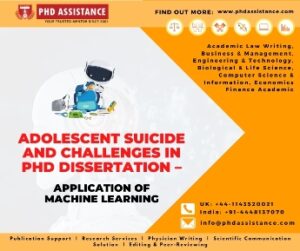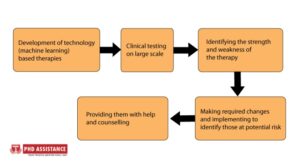Adolescent Suicide and Challenges in PhD Dissertation – Application of Machine Learning
Introduction:
According to the world health organization, one of the most common causes of death among 15-19 years old is suicide. One-third of this fraction occurs in low- and middle- income countries (WHO, 2019). Adolescence is a period where human beings are vulnerable to the external environment and can react positively or negatively towards things happening around them. Adolescent suicide has emerged as a challenging public health problem in the last decade. The recent pandemic and the growing usage of social media may escalate the rate further in the near future. With the Introduction of Technology in almost all aspects of life, medicine has also been transformed by the use of technology-based therapies. Researchers and clinicians have begun experimenting and evaluating the use of technology in the prevention and management of severe conditions. A search strategy based study found that new technologies were slowly becoming easy and adopted support tools for the prevention of suicide in adolescents. It also suggested the efficiency of telepsychiatry and mobile applications in preventing suicide(Forte 2021).

Impact of Machine Learning:
Artificial Intelligence (AI) and Machine Learning (ML) have emerged as essential tools to investigate large sets of data and enhance the detection of risk. Thesis Techniques have attracted the attention of researchers from the mental health community and computational psychiatry (Navarro 2021). Recent studies have shown promising results for the use of machine learning in suicide prevention. The analysis of social media data through machine learning comes across as a promising tool to identify environmental factors that contribute to the development of suicidal thoughts and behaviours in an individual (Bernert 2020). An algorithm known as the “Suicide Artificial Intelligence Prediction Heuristic (SAIPH) was developed to predict future risk to suicidal thoughts through the analysis of data available publicly on Twitter. This algorithm was found to be successful in distinguishing individuals who had a history or plan of suicide. It critically succeeded at identifying not only the people who were at risk but also those who may likely be at risk. However, It had one specific drawback of whether or not someone will tweet about suicide (Roy 2020). Another study found the implementation of a smartphone app to be feasible when recording speech in adolescent mental health therapy sessions(Cohen 2020).

Fig 1: Basic Steps Involved in Machine Learning Based Therapy for Suicide Prevention
Recent Research around this Field:
In recent research, Haroz et al. combined machine learning with community-based suicide surveillance to help identify those at risk. Their study proves the ability of Machine Learning Methodologies to determine those at high risk in the community (Haroz 2020). A case-cohort study utilized CART modelling and Random forest to develop sex-specific risk models as a suicide prevention strategy. The results of this study can be used as a foundation for further research on adolescent suicide (Gradus 2020).
Hill et al. applied classification tree analysis to prospectively determine suicide attempters within a huge adolescent community sample. They concluded that the tree methodology can act as a powerful tool to identify individuals at suicide risk. According to this study, the classification tree analysis can generate easy-to-implement decision rules and customized screening procedures (Hill 2019). In another paper, researchers developed machine learning models for predicting suicidal behaviour in children and adolescents based on their clinical history, as well as identifying short- and long-term risk factors. Their findings depicted the application of EHRs (Electronic health records) as a predictive tool to predict suicide risks among adolescents and children with accuracy (Chang 2020).
Future Scope:
The first and foremost step to reduce the rate of adolescent suicide is to identify those at potential risk and provide them with help. Despite decades of research, identification and understanding of suicide risk still remain challenging. If used appropriately, both AI and ML can crucially help identify early detection of suicide risk, treatment development and important methodological cautions (Bernert 2020). Further research around this field can help in highlighting the causes impeding the prevention strategies and steps that can be taken to overcome them. Researchers may use Machine Learning Techniques to consider hundreds of potential factors at once and decide the most powerful and efficient algorithm to predict a new observation without making any assumptions (Navarro 2021). The development of new machine learning methods and testing these techniques on a large scale can further elevate the prevention and management strategies involved in adolescent suicide.
References:
- Bernert, R. A., Hilberg, A. M., Melia, R., Kim, J. P., Shah, N. H., & Abnousi, F. (2020). Artificial intelligence and suicide prevention: a systematic review of machine learning investigations. International journal of environmental research and public health,17(16), 5929.
- Cohen, J., Wright-Berryman, J., Rohlfs, L., Wright, D., Campbell, M., Gingrich, D.,… & Pestian, J. (2020). A feasibility study using a machine learning suicide risk prediction model based on open-ended interview language in adolescent therapy sessions. International journal of environmental research and public health, 17(21), 8187.
- Forte, A., Sarli, G., Polidori, L., Lester, D., & Pompili, M.(2021). The role of new technologies to prevent suicide in adolescence: A systematic review of the literature. Medicina, 57(2),109.
- Gradus, J. L., Rosellini, A. J., Horvath-Puho, E., Street, A. E., Galatzer-Levy, I., Jiang, T., … & Sorensen, H. T. (2020). Prediction of sex-specific suicide risk using machine learning and single-payer health care registry data from Denmark. JAMA psychiatry, 77(1),25-34.
- Haroz, E. E., Walsh, C. G., Goklish, N., Cwik, M. F., O’Keefe, V., & Barlow, A. (2020). Reaching those at highest risk of suicide: Development of a model using machine learning methods for use with Native American communities. Suicide and Life- Threatening Behavior, 50(2), 422-436.
- Hill, R. M., Oosterhoff, B., & Do, C. (2020). Using machine learning to identify suicide risk: a classification tree approach to prospectively identify adolescent suicide attempters. Archives of suicide research, 24(2), 218-235.
- Navarro, M. C., Ouellet-Morin, I., Geoffroy, M. C., Boivin, M., Tremblay, R. E., Cote, S. M., & Orri, M. (20210. Machine learning assessment of early life factors predicting suicide attempt in adolescence or young adulthood. JAMA network open, 4(3), e211450-e211450.
- Roy, A., Nikolitch, K., McGinn, R. Et al. (2020). A machine learning approach predicts future risk at suicidal ideation from social media data. Npj Digit. Med. 3,78.
- Su, C., Aseltine, R., Doshi, R., Chen, K., Rogers, S. C., & Wang, F. (2020). Machine learning for suicide risk prediction in children and adolescents with electronic health records. Translational psychiatry, 10(1), 1-10.
- World Health Organization ( 2019, 02 September “SUICIDE.” Retrieved from
- Newsroom fact sheet on suicide details.
 Previous Post
Previous Post Next Post
Next Post
